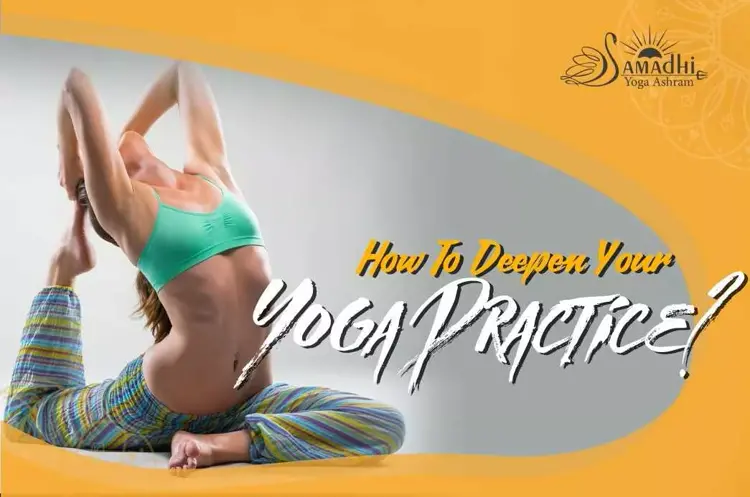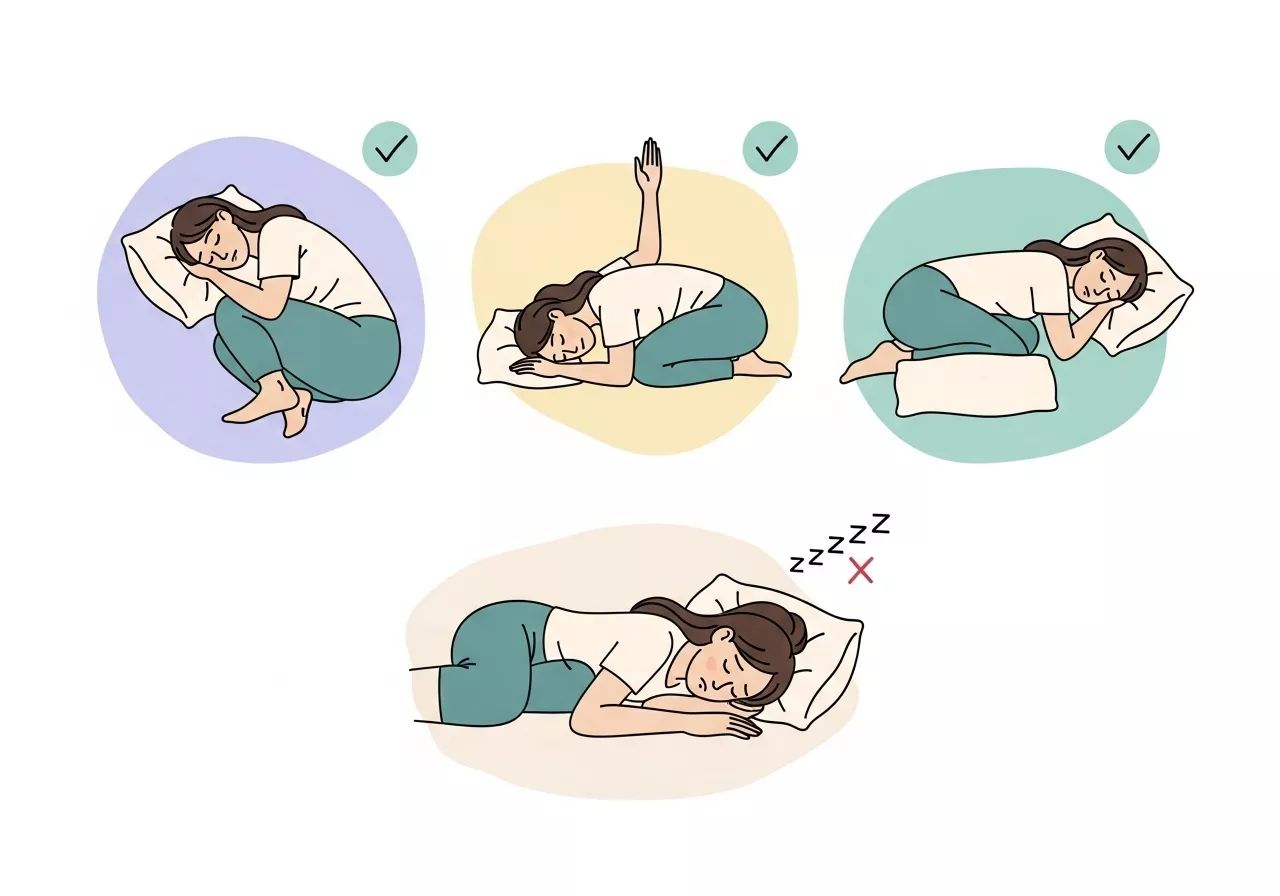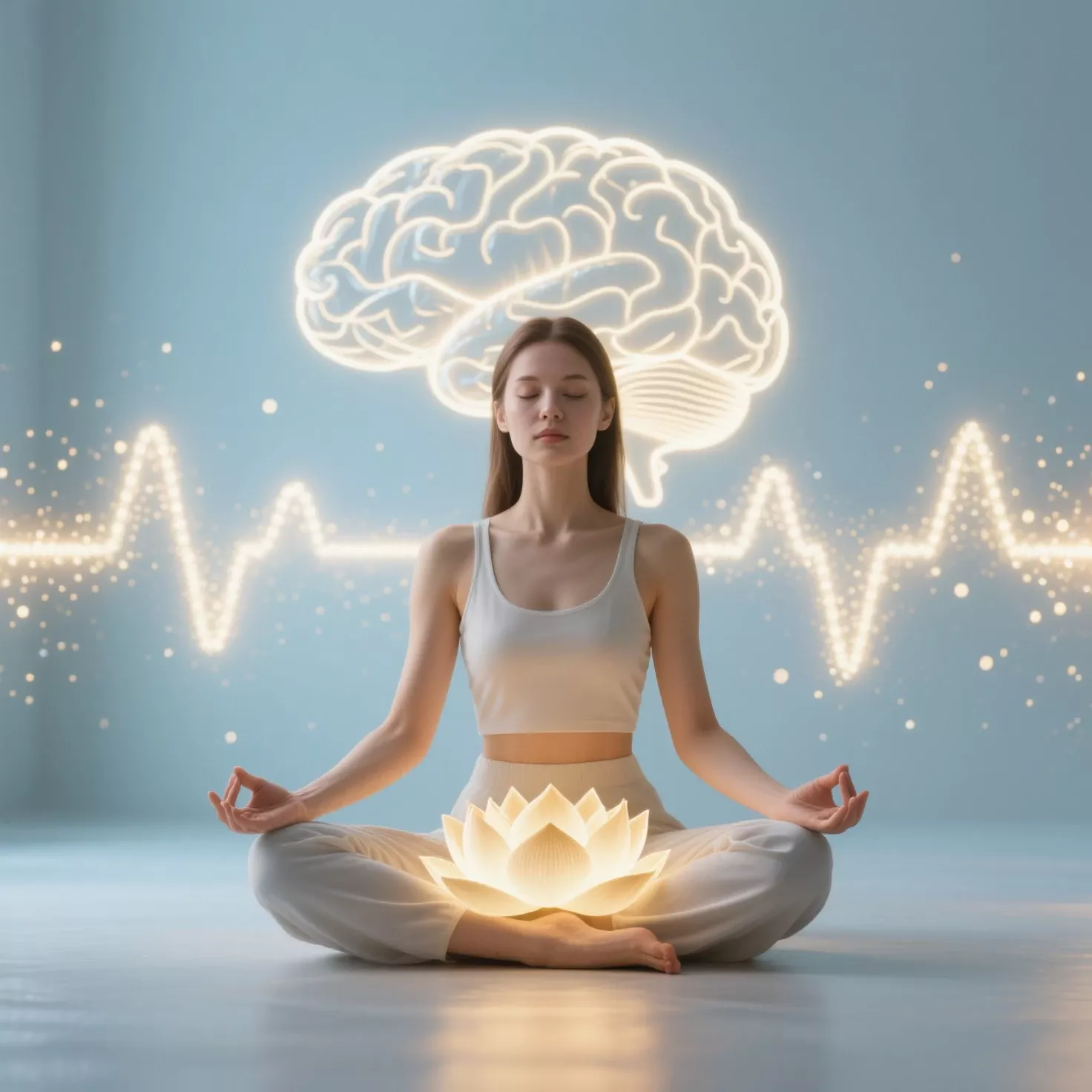Enhancing the depth of your yoga poses requires mindful practice and attention to your body’s signals.
Here are six strategies to deepen your practice safely:

Understand Your Body
The first step to safely deepening your yoga poses is cultivating an awareness of your body’s unique characteristics, including its strengths, weaknesses, and limitations.

Everyone’s body is different due to factors like lifestyle, injury history, and natural flexibility. For instance:
- Runners: Often, runners experience tight hamstrings from repetitive movement patterns. To accommodate this, keeping a slight bend in the knees during poses like forward folds can prevent strain while still offering a meaningful stretch.
- Desk Jobs: Prolonged sitting tends to create tight hip flexors and a compressed lower back. To counteract this, prioritize poses that decompress the spine, such as Bridge Pose or Sphinx Pose, while focusing on engaging your core to protect your lower back.
- Hypermobile Individuals: Those with naturally flexible joints may overstretch or rely on their flexibility rather than strength. Instead, they should focus on building stability in poses by engaging the muscles around the joints to avoid long-term injury.
Listening to your body is crucial. Differentiate between discomfort that signals growth and sharp pain that may indicate a risk of injury.
If you feel pain or strain in a pose, back off and try a modified version or use props for support.
This approach ensures that each step forward in your yoga practice is both intentional and safe.
Taking time to truly understand your body allows you to approach your yoga journey with mindfulness and care, making it easier to deepen your poses over time while respecting your physical boundaries.
Optimize Your Warm-Ups
Preparing your body adequately before attempting deeper poses is essential to enhance flexibility and reduce the risk of injury.
A well-structured warm-up increases blood flow to the muscles, improves joint mobility, and primes your body for more intensive movements.

Here’s how to create effective warm-up sequences tailored to your practice:
- Focus on Dynamic Movements: Incorporate dynamic stretches and transitions that gently wake up the muscles you’ll use in your peak poses. For example, if you’re working toward deeper backbends like Wheel Pose, include Cat-Cow stretches to mobilize the spine, Sphinx Pose to gently activate the lower back, and Low Lunge to open the hip flexors.
- Include Related Preparatory Poses: Identify the muscle groups and joints that will be most engaged in your target pose. For arm balances, warm up the wrists with poses like Plank or Tabletop while integrating gentle wrist stretches. For forward folds, activate your hamstrings with poses like Half Splits or Downward-Facing Dog before attempting deeper stretches.
- Don’t Neglect Core Engagement: Strengthening and engaging your core during warm-ups creates stability, which is crucial for safely deepening poses. Incorporate moves like Boat Pose or Forearm Plank to awaken the core muscles, which act as the foundation for poses requiring balance or flexibility.
- Progress Gradually: Move from gentler to more intense poses, allowing your body to adapt naturally. For example, before attempting a deep hip opener like Pigeon Pose, flow through Warrior II and Bound Side Angle Pose to ease the hips into openness.
Remember, rushing through your warm-up can result in stiffness or strain, making it harder to deepen poses safely.
By spending sufficient time on a thoughtful, progressive warm-up, you create a strong foundation for exploring your practice with confidence and care.
Incorporate Counter Poses
To maintain balance and protect your body during a yoga practice, counter poses are crucial.
These poses serve to neutralize, stretch, or decompress the areas of the body engaged during a specific pose, helping to restore equilibrium and prevent strain.

Thoughtfully integrating counter poses allows your muscles and joints to recover, ensuring a safer and more effective progression into deeper stretches.
Here’s how to utilize counter poses:
- Neutralizing Intense Backbends: After performing deep backbends like Upward Bow (Wheel Pose) or Camel Pose, the spine and chest are in an extended state. Counter this with forward folds or gentle spinal flexion, such as Child’s Pose or Seated Forward Fold. These poses release tension in the lower back and stretch areas that may have been compressed during the backbend.
- Releasing After Forward Folds: Prolonged forward bending compresses the front body and lengthens the posterior chain. Counter poses like Low Cobra or Sphinx Pose gently open the chest and restore the natural curvature of the spine, preventing overstretching of the hamstrings.
- Balancing Twists: Twisting poses create rotation in the spine, which can leave one side of the body tighter than the other. Follow up with symmetrical poses, like a simple seated forward fold, to realign and balance both sides.
- Wrists and Shoulders in Weight-Bearing Poses: Poses like Plank, Downward Dog, or Crow Pose place significant pressure on the wrists and shoulders. Counter these with wrist stretches—like gentle rotations or palms-down wrist extensions—and shoulder openers like Eagle Arms or Puppy Pose to release built-up tension.
- Opening the Hips Post-Splits or Pigeon Pose: After deep hip openers, bring balance to the pelvis with gentle movements that activate surrounding muscles. Bridge Pose or Supine Twist can provide relief by engaging and stretching complementary areas.
Counter poses are not just about physical balance—they also provide an opportunity for mental reset.
Pausing to breathe deeply and allow your body to settle into these movements reinforces mindfulness and prevents overexertion during your practice.
Utilize Props
Yoga props are invaluable tools for enhancing your practice and safely exploring deeper variations of poses.

Far from being a sign of weakness, props help ensure proper alignment, prevent injury, and build the strength and flexibility necessary to progress.
Here’s how to use props effectively to deepen your yoga practice:
Blocks for Stability and Depth: Yoga blocks provide extra height and support, helping you maintain alignment while working toward greater flexibility. For example:
- In Half Moon Pose, placing a block under your lower hand can help you stabilize while extending fully into the pose.
- In seated forward folds, placing a block beneath your forehead allows you to relax deeper into the stretch without straining your spine.
Straps for Extension and Support: Yoga straps are excellent for increasing reach and maintaining proper alignment in poses requiring extended flexibility. For example:
- In Seated Forward Fold, use a strap around your feet to gently pull yourself forward while keeping your back straight.
- In Dancer’s Pose, a strap can help bridge the gap between your hand and foot, allowing you to deepen the pose gradually without overreaching.
Bolsters for Comfort and Decompression: Bolsters offer firm yet cushioned support, ideal for restorative and deep stretches. For instance:
- In Reclined Butterfly Pose, place a bolster along your spine to gently open the chest and shoulders while relaxing the lower back.
- In Child’s Pose, resting your torso on a bolster can make the pose more accessible for those with tight hips or lower back discomfort.
Blankets for Alignment and Cushioning: A folded blanket can be used to elevate the hips, provide support for knees, or pad sensitive areas. For example:
- In Pigeon Pose, sliding a blanket under your hip can help balance uneven alignment, enabling a deeper and more comfortable stretch.
- For seated poses, sitting on a blanket can prevent rounding of the lower back and enhance spinal alignment.
Walls and Chairs for Accessibility: Using a wall or chair can help with balance and stability in standing poses or inversions. For example:
- Practice Handstand or Forearm Stand against a wall to build confidence and develop the strength needed for freestanding versions.
- Use a chair for supported poses, such as Seated Forward Bend or supported backbends, to explore deeper movements with minimal strain.

By incorporating props, you create a bridge between where your body is now and where you want it to be.
They empower you to experience the benefits of poses at every stage of your practice, building strength, flexibility, and confidence gradually and safely.
Practice Consistently
Consistency is the cornerstone of progress in yoga. Regular practice not only enhances strength and flexibility but also deepens your mind-body connection, allowing you to explore poses with greater ease and awareness over time.

Here’s how a consistent approach can transform your yoga practice and help you safely advance into deeper poses:
1. Build Strength Gradually
Regular practice allows your muscles to adapt and strengthen steadily, creating the support needed for more challenging poses. For instance:
- Holding poses like Warrior II, Chair Pose, and Plank over time builds endurance and stability in the legs, core, and shoulders.
- These foundational poses prepare you for advanced variations, such as arm balances or deep lunges, by fortifying key muscle groups.
2. Improve Flexibility Over Time
Flexibility doesn’t happen overnight—it’s the result of consistently stretching and lengthening your muscles.
- By practicing poses like Forward Fold, Butterfly, or Half Splits regularly, you gently expand your range of motion.
- Repeating these stretches consistently signals to your body that it’s safe to release tension, reducing the risk of overstretching or injury.
3. Develop Muscle Memory
Consistency helps your body learn and remember the mechanics of each pose. This muscle memory is crucial for executing complex movements safely and efficiently. For example:
- Repeated practice of foundational poses like Chaturanga or Downward Dog reinforces proper alignment and transitions, building the groundwork for more advanced flows.
4. Cultivate Awareness and Patience
Daily or frequent practice helps you develop a deep awareness of your body’s signals.
- You’ll learn to distinguish between the discomfort that signals growth and pain that warns of potential injury.
- Consistency also teaches patience, as progress in yoga often comes in small, incremental steps.
5. Create a Ritual of Growth
Establishing a regular practice schedule—whether it’s 15 minutes a day or an hour several times a week—creates a positive ritual that fosters both physical and mental growth.
- Pair consistent practice with intentional breathing techniques (pranayama) and mindfulness to enhance your focus and relaxation during each session.
6. Track Progress and Set Goals
Consistency allows you to monitor your progress and set realistic milestones for deepening your practice.
- For example, you might start with holding Tree Pose for 10 seconds and gradually work up to a minute or more.
- Celebrate small victories, such as reaching deeper into a stretch or achieving stability in a balance pose, to stay motivated.
By practicing consistently, you’ll unlock the potential of your body and mind, progressing toward deeper poses with confidence and care.
Remember, yoga is not about rushing to achieve perfection but embracing the journey of growth one practice at a time.
Seek Guidance
Even the most seasoned yogis can benefit from the expertise of an experienced instructor.

Seeking guidance ensures you are practicing safely, progressing effectively, and tailoring your practice to suit your unique needs.
Here’s why working with a yoga teacher or mentor can significantly enhance your journey:
1. Receive Personalized Adjustments
Instructors can observe your practice and offer hands-on or verbal adjustments to refine your alignment. For instance:
- If you struggle with hip placement in Warrior I, an instructor can guide you to square your hips, ensuring you engage the correct muscles and avoid strain.
- Personalized feedback helps correct imbalances that might otherwise lead to injury or hinder progress.
2. Learn Proper Technique
A skilled teacher can break down the mechanics of challenging poses, helping you understand how to enter, hold, and exit safely.
- For example, they might teach you how to distribute weight evenly in your hands during Crow Pose or engage your core effectively in Boat Pose.
- Understanding the “why” behind each movement fosters better body awareness and confidence in attempting deeper poses.
3. Explore Modifications and Variations
An instructor can suggest modifications if a pose feels inaccessible or variations to challenge you further.
- If you’re not yet comfortable in a deep backbend like Camel Pose, your teacher might recommend using a block for support or starting with a gentler backbend like Bridge Pose.
- Conversely, they can introduce advanced variations, such as transitioning from Side Angle Pose to Bound Side Angle, when you’re ready.

4. Benefit from Expert Sequencing
Yoga teachers craft sequences that prepare your body progressively for peak poses, ensuring your muscles are warmed up and activated in the right way.
- For example, a teacher might sequence a series of twists, hip openers, and shoulder stretches to prepare you for a pose like Revolved Triangle.
- This approach prevents strain and helps you access deeper stretches safely.
5. Gain Insight into Yoga Philosophy
Beyond physical practice, experienced instructors often weave in teachings about yoga’s philosophical aspects, breathing techniques (pranayama), and meditation practices.
- This holistic approach enriches your practice and fosters a deeper connection between your mind, body, and spirit.
6. Stay Motivated and Accountable
Regularly attending classes or scheduling one-on-one sessions with an instructor helps maintain consistency and keeps you motivated.
- A teacher can help you set realistic goals, track your progress, and provide encouragement to overcome plateaus.
- They also create a supportive space where you feel empowered to try new poses without fear of judgment.
7. Adapt Practice for Special Needs
Instructors are particularly valuable if you’re recovering from an injury, managing chronic conditions, or dealing with specific physical challenges.
- A knowledgeable teacher can recommend poses that aid in recovery and suggest practices to avoid aggravating existing issues.
Seeking guidance ensures that your practice evolves in alignment with your body’s capabilities and aspirations.
Whether through group classes, private lessons, or online sessions, investing in expert instruction is a powerful way to deepen your yoga journey while maintaining safety and mindfulness.
By integrating these approaches, you can safely enhance the depth of your yoga poses, aligning with your body’s needs and capabilities.



